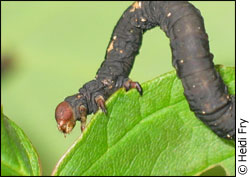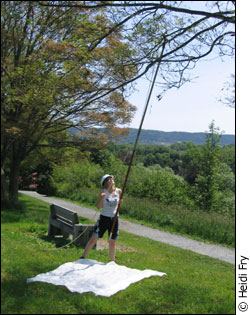
|
For the last five years, the elm spanworm, a native pest to Newfoundland, as well as parts of the north-eastern United States, has wreaked nothing short of havoc in the urban areas of St. John's. This black inchworm, about the size as your index finger, spends its time stripping city trees of all their leaves, as well as covering houses, sidewalks, driveways, lawn furniture and cars with silk strands and feces.
Heidi Fry is a Masters student in biology at the University of New Brunswick in Fredericton, and a St. John's native. She knows all too well the affect the elm spanworm is having on her city, and has devoted her Masters project to finding a way to contain the outbreak. "They're just everywhere," she said at a recent university conference where she outlined her project to a panel of experts. "It's causing a real problem." Though the worm's silk strands and feces which blanket parts of the city every summer pose no health risk to humans, Fry says, they do cause an unsightly mess. And defoliated trees mean that residents are robbed of shade from the hot summer sun — even in foggy St. John's. The feces, or frass, was also responsible for a few accidents in the city. "Last year several seniors slipped on sidewalks that were covered in feces and morning dew," says Fry. "Their frass is very tiny and hard, but it mostly just stains sidewalks." Last summer Fry spent four months in St. John's studying the elm spanworm in all its stages. According to the City of St. John's website, eggs are laid in the fall (usually September) and must survive the winter on their own until the larva hatch in June and July. It creates a nuisance throughout the summer until it pupates in August. Finally, the harmless snow-white linden moth emerges in late August and September to begin the cycle all over again. Fry heads to St. John's around May, and starts her research by identifying random trees around the campus of Memorial University that will become part of her sample. Elm spanworm only attacks deciduous trees, or trees that lose their foliage over the winter. Its favourite leaves to munch on belong to maple, linden, beech, chestnut, oak and of course, the elm, all of which can be found in city parks, along streets and on private properties. In the field To collect her samples, Fry uses a device called a pole-pruner.
"It's basically a long pole that has a blade on the top that swings down when I pull a rope," she says. "I sampled two branches from each of my sample trees, brought the branches back to the lab and looked for egg masses on the bark of the branches." Egg masses are counted on each branch. From there, Fry can make an assessment of the levels of defoliation that will occur in different parts of the campus, which spreads throughout many areas of the city. "It's predicted that an area with high-egg density will have high-larval density and therefore will have high levels of defoliation." Fry samples the trees in this same manner later on in the season to assess the larval density, and to see if her hypothesis is correct. She says the information is also useful to city officials, who will then be able to implement control measures in the most highly effected areas. "It's better than just spraying everywhere," Fry says. To spray or not to spray But according to David Evans, senior arborist with the City of St. John's, though the elm spanworm outbreak does fall squarely within the city's jurisdiction, it has decided not to take any direct measures to control the population.
"I'm the guy people want to hold somewhat responsible for the outbreak because people want to us to use a spray program and we don't," he says. According to Evans, the reason for this is that "for every person who wants to use cosmetic pesticides, you'll find five others who don't." Instead, Evans says the city provides literature to the public on what works, and generally leaves residents to deal with it in their own manner. The data collected by Fry doesn't go to waste at the city, however. After she assesses which areas will be the strongest hit by the worm, the city is able to create brochures and mails them out to residents in those areas. Evans says they only time the city will intervene with pesticides is if a tree of significance on city property has the potential to sustain significant damage. "If we felt that a major historic tree, which we have here in St. John's, would be put under stress by the elm spanworm, we might spray then, but otherwise people are mostly on their own." Natural alternatives The only pesticide authorized for use against the elm spanworm is Bacillus thuringiensis kurstaki, or Btk. It's a cosmetic pesticide, meaning that it is sprayed on all surfaces of the pest-affected area. Alternative options, chemical and otherwise, are also a large part Fry's field research. Last summer she tested the efficacy of a systemic insecticide called AceCap 97, with positive results. Systemic insecticides come in capsules which are drilled in a spiral pattern around the base of the tree trunk. The insecticide then travels up the tree internally to the leaves where hungry elm spanworm meet their demise. The obvious advantage of systemic over cosmetic pesticides is that the chemicals are more directed. They are only found in the tree, and cannot transfer to other surfaces. According to Krista Royall, Fry's co-supervisor and an entomologist with Natural Resources Canada's Canadian Forest Service, once leaves fall from the trees, the chemical breaks down and becomes harmless to anyone or thing that might come in contact with it. But she warns that AceCap 97 has not yet been approved by the Pest Management Regulatory Agency of Health Canada for use against elm spanworm, nor does it appear on the product label. "I've heard of people ordering it off the Internet to use against the elm spanworm, and they really shouldn't be doing that," Royall says. "It's strong stuff and should only be handled by licensed professionals."
An even safer alternative helped to contain similar outbreaks along the north-eastern United States in the 1970s. A natural enemy known as wasp egg parasitoids were used. This parasite feeds on elm spanworm eggs. The only problem with this, Royall says, is that studies indicate that the parasitoids doesn't exist in the St. John's area. "We found absolutely none last year, which was disappointing." Introducing the wasp might be an option, but she says that because Newfoundland is an island, "we wouldn't do so without a lot of research and a lot of restrictions." The city maintains that none of these measures will be necessary, because levels of elm spanworm are going down on their own. Letting nature take its course "The problem will correct itself," says Evans. "It's like the rabbit and the fox analogy. If the fox eat all the rabbit, the fox population goes down because they've got nothing left to eat." Royall is more skeptical, saying that populations are not dwindling, they're just moving. "Areas that have been hardly affected in the past are now becoming more affected," she says. "It's basically just making its way around the city." The good news, for everyone outside St. John's at least, is that the elm spanworm seems to be contained within the city. Royall says the reason that it stays there and is unlikely to spread further is very simple. "The region outside the city is either rocky and barren of full of conifers, evergreen trees. Since the worm only attacks deciduous trees, it really has nowhere to go." Royall says little is known about other past outbreaks, both those in Canada and the United States, because this is the first time an outbreak has affected such a large urban centre for so long. Still, she is against the use of pesticides, and says as long as people are patient, the issue will address itself. "Nature has a way of correcting these imbalances," she says. "It can't go on forever."
|
|
|

